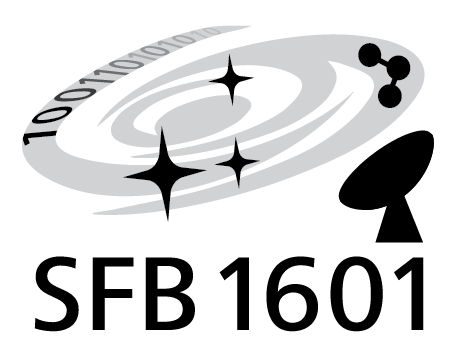Project leaders: Riechers, Dominik (PH1); Bertoldi, Frank (AIfA)

This sub-project covers the far largest scales on which massive stars impact the evolution of the universe spectroscopically, with the goal to obtain a tomographic map of the distribution and clustering of star-forming galaxies in the early Universe up to redshifts of 8. Through line intensity mapping (LIM) in rest-frame far-infrared to sub-millimeter lines from the habitats of massive stars in galaxies on Mpc to tens of Mpc scales, it will become possible to determine line luminosity functions throughout cosmic history for those species that dominate the signal from the cold and star-forming interstellar medium, which leads to the cosmic star formation history that is the subject of project C2. More importantly, it will become possible to constrain the distribution of hydrogen-ionizing photons during cosmic reionization by using tracers of the UV field in star-forming galaxies to measure their clustering. This will yield three-dimensional information on the expected progression of cosmic reionization, which can then be combined through cross-correlation with the redshifted H I 21 cm signal from the (disappearing) neutral intergalactic medium at the same redshifts to be measured by the SKA to measure the full structure of the reionization process.
2025
HerS-3: An Exceptional Einstein Cross Reveals a Massive Dark Matter Halo Journal Article
In: Astrophysical Journal, vol. 991, no. 1, pp. 53, 2025.
The Diamond Ring in Cygnus X: Advanced stage of an expanding bubble of ionised carbon Journal Article
In: Astronomy & Astrophysics, vol. 703, iss. A197, pp. 14, 2025.
[C II]-deficit caused by self-absorption in an ionized carbon-filled bubble in RCW79 Journal Article
In: A&A, vol. 697, pp. L2, 2025.
Do Unusually Cold Starburst Galaxies Exist? A Case Study Journal Article
In: Astrophysical Journal, vol. 980, no. 1, pp. 59, 2025.
2024
[CII] luminosity models and large-scale image cubes based on COSMOS 2020 and ALPINE-ALMA [CII] data back to the epoch of reionisation Journal Article
In: A&A, vol. 689, pp. A101, 2024.
References
- Breysse, Padmanabhan, Liu, Bond, Cleary, Crichton, 10 co-authors including, and Riechers, “Astrophysics and Cosmology with Line Intensity Mapping”, 2020, 38 (2019).
- CCAT-Prime collaboration, Aravena, Austermann, 84 co-authors including, Bertoldi, Bigiel, Schilke, and Simon, “CCAT-prime Collaboration: Science Goals and Forecasts with Prime-Cam on the Fred Young Submillimeter Telescope”, (2021).
- Kovetz, Viero, Lidz, Newburgh, Rahman, Switzer, 42 co-authors including, and Riechers, “Line-Intensity Mapping: 2017 Status Report”, arXiv e-prints, arXiv:1709.09066 (2017).
- Pavesi, Riechers, Capak, Carilli, Sharon, Stacey, Karim, Scoville, et al., “ALMA Reveals Weak [N II] Emission in “Typical” Galaxies and Intense Starbursts at z = 5-6”, ApJ 832, 151 (2016).
- Pavesi, Riechers, Sharon, Smolcˇic ́, Faisst, Schinnerer, Carilli, Capak, et al., “Hidden in Plain Sight: A Massive, Dusty Starburst in a Galaxy Protocluster at z = 5.7 in the COSMOS Field”, ApJ 861, 43 (2018).
- Riechers, Bradford, Clements, Dowell, Pérez-Fournon, Ivison, Bridge, Conley, et al., “A dust-obscured massive maximum-starburst galaxy at a redshift of 6.34”, Nature 496, 329 (2013).
- Riechers, Carilli, Capak, Scoville, Smolcˇic ́, Schinnerer, Yun, Cox, et al., “ALMA Imaging of Gas and Dust in a Galaxy Protocluster at Redshift 5.3: [C II] Emission in “Typical” Galaxies and Dusty Starbursts ⇡1 Billion Years after the Big Bang”, ApJ 796, 84 (2014).
- Riechers, Hodge, Pavesi, Daddi, Decarli, Ivison, Sharon, Smail, et al., “COLDz: A High Space Density of Massive Dusty Starburst Galaxies ⇠1 Billion Years after the Big Bang”, ApJ 895, 81 (2020).
- Riechers, Pavesi, Sharon, Hodge, Decarli, Walter, Carilli, Aravena, et al., “COLDz: Shape of the CO Luminosity Function at High Redshift and the Cold Gas History of the Universe”, ApJ 872, 7 (2019).
- Stacey, Aravena, Basu, Battaglia, 36 co-authors including, Bertoldi, Riechers, and Schilke, “CCAT- Prime: science with an ultra-widefield submillimeter observatory on Cerro Chajnantor”, Society of Photo-Optical Instrumentation Engineers (SPIE) Conference Series 10700, edited by Marshall and Spyromilio, 107001M (2018).
